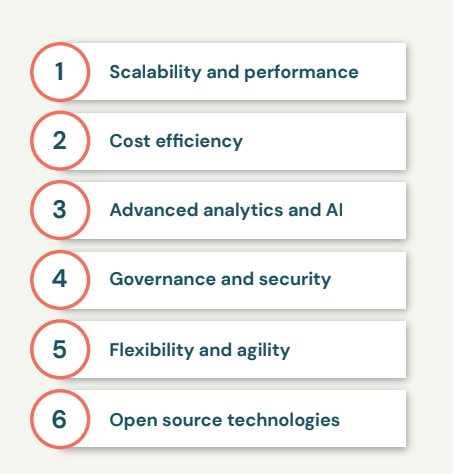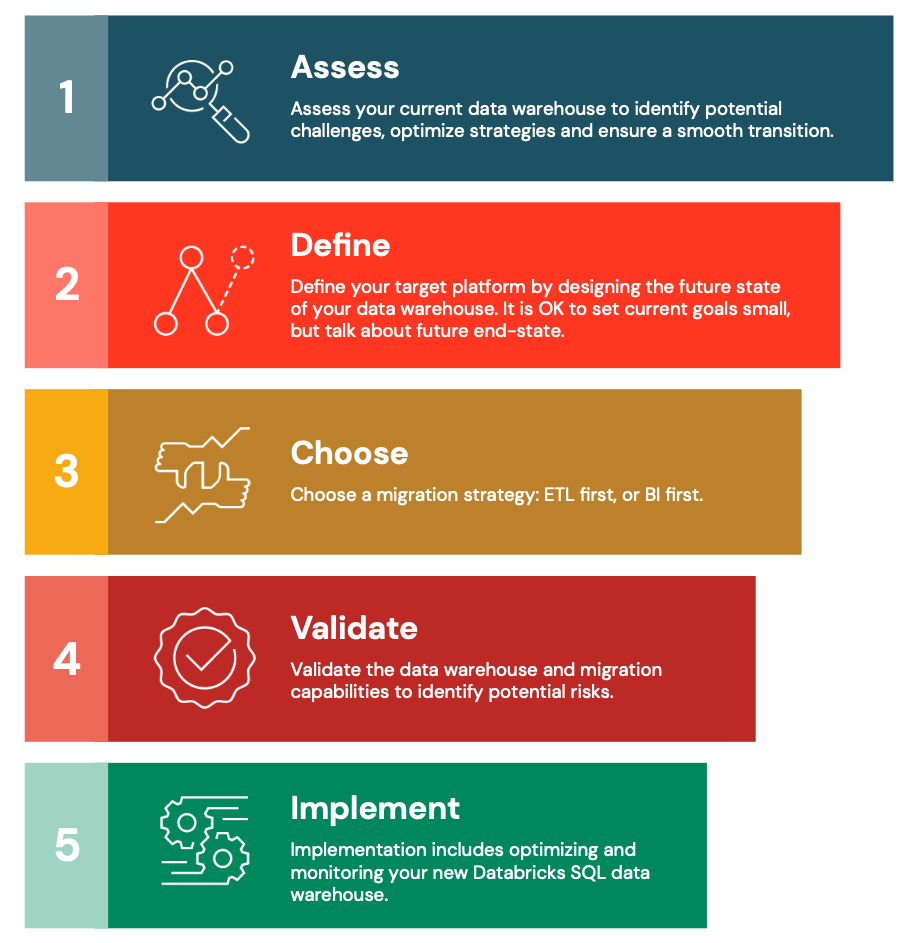How Databricks Simplifies Data Warehouse Migrations with Proven Strategies and Tools
A low-risk, predictable path to modernizing your data warehouse

Summary
- Learn why modernizing your data warehouse to the lakehouse improves scalability, cost savings, and advanced analytics.
- Discover what makes EDW migrations successful—with Databricks’ step-by-step strategy.
- Learn how to reduce risk using POCs, MVPs, and built-in Databricks tools.
Modernize your data warehouse by migrating to Databricks
Legacy enterprise data warehouses (EDWs) are becoming a bottleneck for businesses aiming to scale operations and adopt advanced analytics. Traditional EDWs struggle with:
- Scalability: Expensive hardware upgrades delay projects and limit growth.
- Cost efficiency: High upfront capital costs versus flexible pay-as-you-go cloud models.
- Advanced analytics: Limited support for real-time insights, AI, and machine learning (ML).
- Flexibility: Rigid systems that can’t adapt to new use cases or integrate diverse data sources.
Migrating to a modern platform like Databricks offers elastic scalability, reduced costs, built-in security, and the ability to integrate open source technologies, avoiding vendor lock-in. This transformation empowers organizations to unlock real-time analytics and AI-driven decision-making while future-proofing their infrastructure.

Customers are also realizing these advantages of moving to the lakehouse. Check out this case study from Trek Bicycle!
Before Databricks, we had to run our retail analytics once a day on North American time, which meant our other regions got their data late. Now, we refresh the lakehouse three times per day, one for each region, and stakeholders receive fresh data in time to drive their decisions. Based on the results we’ve achieved in the lakehouse, we’re taking a Databricks-first approach to all our new projects. We’re even migrating many of our on premises BI solutions to Databricks because we’re all-in on the lakehouse. — Advait Raje, Team Lead, Data Engineering at Trek Bicycle
A proven strategy for low-risk migration
Migrating an EDW is complex, but doesn’t have to be risky. Databricks provides a structured five-step framework to ensure a smooth transition, which hundreds of customers have used.

Customers have been using this migration strategy to accelerate their migration projects. Check out this case study from VGZ!
Our new data platform was implemented seamlessly within three quarters: one for initial setup and golden source extraction, followed by a quarter dedicated to stabilization. This efficient rollout has brought us results that have exceeded our expectations and left us more than satisfied. — Rohan Horstman, Data Solutions Architect, VGZ
Step 1: Assess
A comprehensive evaluation of your current environment lays the foundation for success. Key assessments include:
- Business use cases: Identify critical workloads and future needs with stakeholder input.
- Architecture evaluation: Document dependencies, data flows, and integration points.
- Technical metrics: Analyze ETL processes, query performance, and compliance requirements.
Step 2: Define
Designing the future state of your data warehouse involves aligning business goals with technical capabilities. This step includes defining key performance indicators (KPIs), too. Modernization choices include:
- Lift-and-shift migration: Quickly decommission legacy systems using automated tools like BladeBridge (now part of Databricks).
- Complete modernization: Rebuild workflows to enable advanced use cases like ML-based predictive analytics.
- Hybrid approach: Start with lift-and-shift, then modernize incrementally by adding new capabilities.
Selecting the right technology stack is critical—Databricks Lakehouse combines Delta Lake storage with distributed computing for scalability and interoperability.
Step 3: Choose
Databricks supports two primary migration strategy approaches:
- Ingestion and ETL first (back-to-front): Build a solid data foundation before migrating dashboards—ideal for gradual optimization.
- BI first (front-to-back): Replicate dashboards first to showcase immediate business value—ideal for driving user adoption early on.
Using Databricks-native features like Lakehouse Federation ensures seamless transitions across both strategies.
Step 4: Validate
Before scaling up migration efforts, validate assumptions and identify potential risks. Validation should include one of the following:
- Proof of Concept (POC): Test the feasibility of specific pipelines or queries.
- Minimum Viable Product (MVP): Deliver essential features on a subset of workloads to demonstrate value quickly.
Clear success criteria ensure confidence in the migration process.
Step 5: Implement
The final step involves full-scale implementation with continuous performance optimization and monitoring. Key focus areas include:
- Data governance and security policies for compliance.
- Performance tuning via indexing, caching, and autoscaling mechanisms.
- Ongoing monitoring to address issues proactively and optimize costs.
Knowledge transfer
The last step with any migration is knowledge transfer. A successful migration extends beyond technical implementation to encompass organizational adoption and expertise development. Ensuring your teams can effectively utilize the Databricks Platform requires deliberate planning for knowledge acquisition and cultural adaptation to new workflows and capabilities.
Make sure you include skills development and change management, as well as thorough documentation and a knowledge base.
Databricks tools that simplify migration
Databricks accelerates migrations with purpose-built features like Delta Lake’s unified storage format, automated ETL pipelines, and integrations with leading ISVs such as Fivetran and Tableau. These tools reduce complexity while enabling real-time analytics and AI-driven insights.
Next steps
Ready to modernize your data warehouse? Download our eBook, “Transforming Legacy Data Warehouses: A Strategic Migration Blueprint,” for detailed strategies and best practices that ensure a low-risk transition to the Databricks Data Intelligence Platform.

